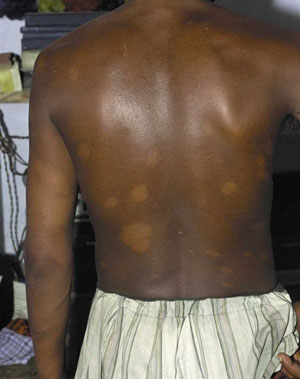Case history
Case history
A 25-year-old married, male farm labourer from a village in Tanzania presents with multiple erythematous patches distributed on the trunk, back, arms, and legs, and with loss of sensation and tingling in his feet and fingers. On examination, papules and plaques of varying sizes between 0.5 and 10.0 cm are present, distributed asymmetrically, mainly over the trunk. He is not malnourished and does not have lymphadenopathy or splenomegaly. His vital signs are normal, and the genital and systemic examinations are normal.[Figure caption and citation for the preceding image starts]: Early multibacillary (MB) leprosyWHO [Citation ends].
Other presentations
Two types of immunological reactions affect 30% to 50% of patients with leprosy: type 1 reaction (reversal reaction) and type 2 reaction (erythema nodosum leprosum). In type 1 reaction, existing skin lesions become erythematous and oedematous, and there may be spontaneous nerve pain, tenderness, paraesthesias, and/or loss of nerve function (claw hand, foot drop, facial palsy); systemic symptoms are unusual. Type 2 reaction includes the rapid appearance of crops of painful, erythematous subcutaneous nodules that can ulcerate; fever; malaise; anorexia; arthralgias; orchitis; epididymitis; iritis; and neuritis. These reactions are often incorrectly viewed as complications of multi-drug therapy. Reactions are medical emergencies that can increase leprosy-related morbidity and it is important to specifically recognise and treat reactions, to reduce the burden of disability in leprosy. A third, relatively rare, reaction is called Lucio's phenomenon. This occurs in diffuse non-nodular lepromatous leprosy (lepra bonita) and has been associated with a different species called Mycobacterium lepromatosis.[4] Symptoms include crops of haemorrhagic infarcts in the skin, and plaques, which become necrotic and ulcerated. Atrophic scars are left behind; systemic symptoms are unusual. Immunological reactions can occur any time, before, during, or after treatment.[5]
Use of this content is subject to our disclaimer